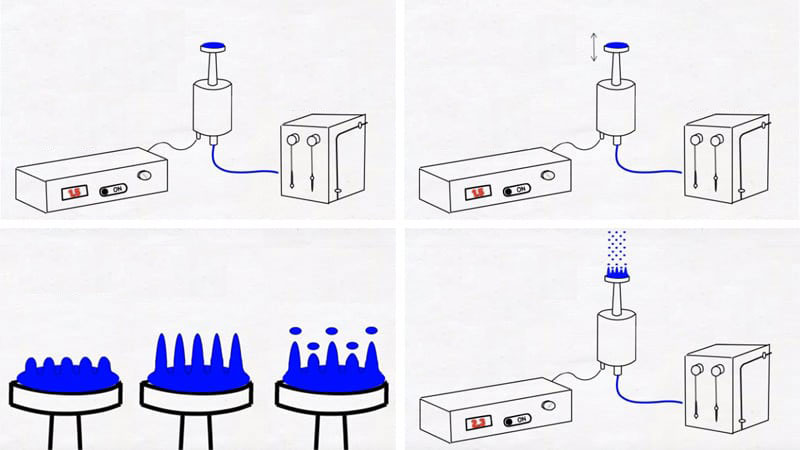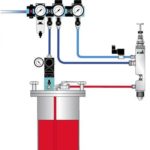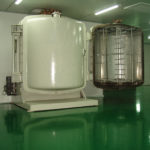
Ultrasonic spraying is a coating deposition process that utilizes ultrasonic atomization technology. Firstly, the coating material to be deposited is configured into liquids such as sols or suspensions, which are then atomized into micron-sized droplets through a special ultrasonic atomization device called ultrasonic nozzle. These atomized coating will then evenly deposited on the substrate surface by pressurized air. Ultrasonic spraying is considered an economical and superior deposition process for certain materials that can be used to obtain a comparable quality coating at affordable deposition equipment such as vapor deposition or sputtering. Comparing to traditional single-fluid or two-fluid spraying (air spraying), ultrasonic spraying has significant advantages such as very soft and uniform atomization, non-clogging spray guns, and highly controllable spray flow, so as to obtain much higher raw material utilization rate (up to 4 times) than two-fluid spraying, higher uniformity and accuracy control, and lower maintenance costs.
The core component of ultrasonic spraying – ultrasonic nozzle
Ultrasonic nozzle, known as ultrasonic nozzle or ultrasonic spray gun, is an ultrasonic atomization device based on the principle of Langevin transducer. The maximum amplitude of ultrasonic waves is designed at the front end of the nozzle, when the liquid is transported from the nozzle back to front end, it is torn into fine droplets by the high-frequency ultrasonic oscillation to form atomization, and then the liquid particles will be sent to the sprayed object or a specific space through a certain amount of carrier gas. The amount of liquid atomization is determined only by the amount of liquid delivered and the operating frequency of the spray head.
The main factor that determines the size of atomization is the ultrasonic frequency, the higher the frequency, the smaller the atomization particle size, we can adjust the ultrasonic nozzle frquency easily to control the size of atomization.
Advantages of Ultrasonic Spraying
Comparing to traditional two-fluid spraying, ultrasonic spraying has the advantages of high coating uniformity, high raw material utilization, high coating thickness accuracy control, thinner coating thickness, less spatter, no blockage of the nozzle, and low maintenance cost, which is a more economical coating process.
1. High coating uniformity
The uniformity of liquid particle distribution after atomization by ultrasonic nozzle is significantly higher than that of the two-fluid nozzle, which is commonly known as the air spray gun, so that the uniformity of the coating after spraying by the ultrasonic nozzle is also improved.In general, the coating uniformity of ultrasonic spraying can reach more than 95%.
2. High utilization rate of raw materials and less spatter
Because ultrasonic spraying is the liquid atomization carried out by ultrasonic oscillation, the process of atomization of the paint does not require any gas, that is, the atomization process does not need pressure, and only a very low carrier gas pressure is applied after atomization to transport the liquid mist, so the liquid rebound and splash caused by the two-fluid spraying high-pressure air are greatly reduced, so as to greatly improve the utilization rate of the coating.The raw material utilization rate of ultrasonic spraying is more than 4 times that of ordinary air spraying, and the utilization rate can reach more than 90%.
3. High precision of coating thickness control
The main factor affecting the accuracy of the coating thickness is the spray flow rate of the paint, which is the amount of material loaded on the substrate per unit time.The ultrasonic nozzle does not have any pressure effect on the liquid, so the flow rate of the atomized sprayed paint liquid can be completely controlled by a high-precision metering pump, thus achieving high-precision spraying flow control.For example, the flow control accuracy of high-precision syringe pumps can reach the level of picoliters per second, and the microfluidic channel design of the ultrasonic nozzle can also achieve the overall control accuracy of nanoliters per second.
4. The coating thickness is thin, which can reach tens of nanometers
Since the spray volume of the ultrasonic nozzle can achieve a very low and stable flow rate (0.001 ml/min), a very low loading capacity can be achieved on the substrate, resulting in a very thin dry film.For some nanomaterials, the dry film thickness can be as low as tens of nanometers.It can be used to prepare glass films such as transparent conductive films, anti-reflection and anti-reflective films, thermal insulation films, hydrophilic and hydrophobic films, etc.
5. The nozzle is not clogged and the maintenance cost is low
Because the ultrasonic nozzle is a liquid atomization achieved by ultrasonic oscillation, and the atomization of particles is determined by the frequency of ultrasonic oscillation, it is different from the two-fluid nozzle, and the pore size of the nozzle does not need to be small to achieve fine atomized particles, so the risk of nozzle clogging is reduced.




